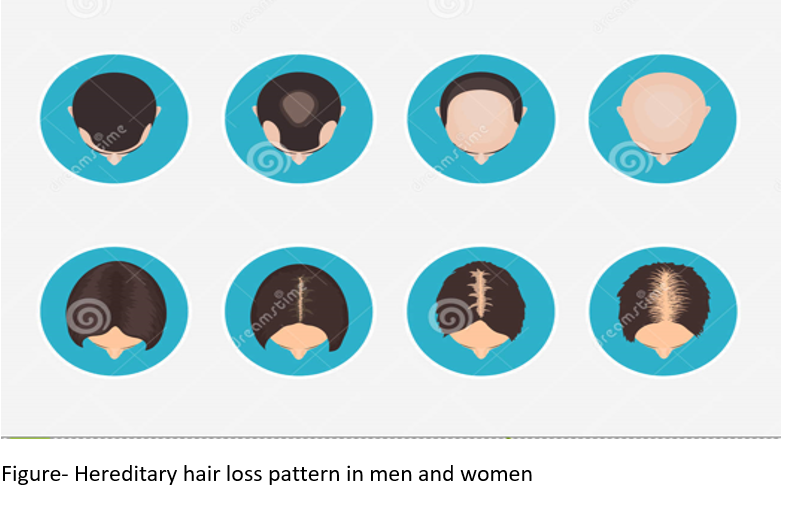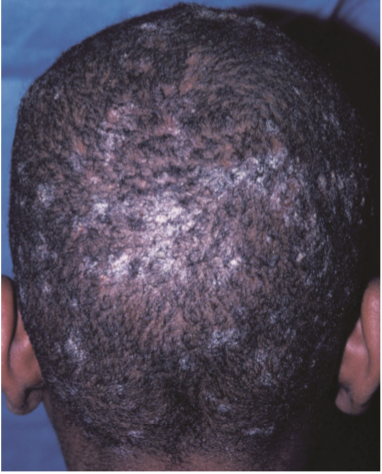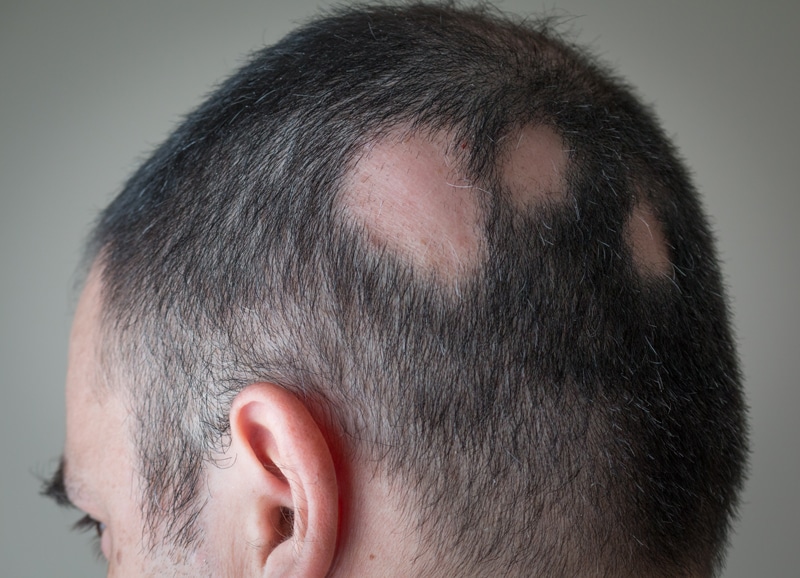
Hair is considered as sign of beauty in almost all culture. Hair loss is the common problem faced by both men and women. It is not life threatening but is distressing and often have significant effect on patient’s quality of life. It can range from mild hair thinning to total baldness.
Medically it falls into several categories, including:
1. Hereditary pattern baldness, or androgenetic alopecia
- Most common form of hair loss in men and women. Compared to men, this condition is less common in women.
- It is usually caused by combination of three factors; an inherited tendency towards baldness, male hormones (androgens) and increasing age.
- Hair thinning occurs in sex specific pattern. In men, it begins with bitemporal thinning, thinning of the frontal and vertex scalp, or complete loss of hair with residual hair at the occiput and temporal fringes. In women, thinning occurs over entire top or crown of the scalp, sparing the front of the scalp.

2. Tellogen effluvium
- This happens two to three months after a major body stress, such as a prolonged illness, major surgery or serious infection. It also can happen after a sudden change in hormone levels, such as after childbirth in women.
- Moderate amounts of hair fall out from all parts of the scalp. Bald spots are very rare.
3. Tinea capitis (fungal infection of scalp)
- Dermatophyte infection of the hair shaft and follicles that primarily affects children. Adults are rarely infected. It may be transmitted from person to person or from asymptomatic carriers.
- Patients with tinea capitis show patchy alopecia with or without scaling.

4. Alopecia areata
- It is an autoimmune disease that causes hair to fall out in small patches. It may be associated with other immune diseases like thyroid and pancreatic diseases.
- Hair loss in alopecia areata occurs in three different patterns: patchy alopecia is circumscribed, oval-shaped, flesh-colored patches on any part of the body; alopecia totalis involves the entire scalp; and alopecia universalis involves the whole body.

5. Trichotillomania
- It is an impulse controlled disorder in which patients consciously or unconsciously pull, twist or twirl their hair. Hair may appear uneven with twisted or broken off hairs.
6. Side effects of drugs
- Most of the medicines used in cancer chemotherapy causes sudden alopecia. Some other drugs like warfarin, heparin, beta-blockers, amphetamines and levodopa also causes loss of hair.
7. Trichorrhexis Nodosa
- It occurs when hairs break due to trauma or because of fragile hair. Causative trauma includes tight hair styles, heat application, excessive brushing, use of strong chemicals (bleaching, hair coloring, permanent waves).
8. Symptoms of a medical illness
- Loss of hair can be one of the symptoms of medical illnesses like syphilis, systemic lupus erythematous (SLE), sex-hormone imbalance, nutritional problem like deficiency pf zinc, protein or biotin. These deficiencies are common in people with restrictive diets and women who have very heavy menstrual flow.
Diagnosis of hair loss
- The diagnosis is based on patient’s medical history, medications taken, nutritional status, hairdressing habits and physical examination. If fungal infection is suspected, doctor may take hair sample for laboratory testing. If medical illness such as lupus or a thyroid problem is suspected, blood test is preferred.
Expected duration of Hair Loss
- The duration of hair loss depends on the cause. For example, in telogen effluvium hair is lost over several weeks to months, but than grows back over the next several months. If hair loss is due to side effects of a medicine, it may happen till therapy is continued and hair growth may return to normal once therapy is stopped. If hair loss is due to abusive hairdressing, the hair loss may stop after you change to more natural styling.
- Male and female pattern baldness (androgenetic alopecia) worsens over time but can be treated. Early treatment is necessary to prevent possible permanent hair loss.
Prevention of Hair Loss
- Some forms of hair loss can be prevented by minimizing stress, eating healthy nutritious diet and using sensible hair dressing techniques.
- Loss of hair due to fungal infection can be prevented by maintaining hair hygiene (cleaning hair and combing regularly, using proper shampoo) and by never sharing comb, brushes or hats with other people.
- Loss of hair from androgenetic alopecia can sometimes be prevented by medication.
Treatment of Hair Loss
- Tinea capitis require antifungal treatments. Oral medications like terbinafine, itraconazole, griseofulvin for 6-12 weeks with or without shampoos containing selenium sulfide or ketoconazole are used. All close contacts of patients with tinea capitis should be examined and treated if necessary.
- Alopecia areata can be treated by using topical mild to high potency corticosteroids, minoxidil, anthralin, immunotherapy and systemic corticosteroids or combination of these therapies.
- If it is due to nutritional deficiency or medical illness stops with adoption of healthy diet and treatment of causative medical condition. Limiting chemical and physical exposure (use of colors, bleaching agents, hair dryers, straighteners) is also useful in stopping alopecia.
- Hair loss due to medical therapies or telogen effluvium requires no treatment other than discontinuing the medication which is causing the condition.
- For trichotillomania, no known optimal treatment is available and psychiatric referral may be indicated. Treatment options include cognitive behavior therapy and selective serotonin reuptake inhibitors (though strong evidence of its effectiveness hasn’t been demonstrated).
- Many men and women with hereditary baldness don’t go for treatment. In this kind, therapy begins with topical minoxidil. If minoxidil is not effective, premenopausal women can be treated with estrogen or spironolactone (anti-androgen drug) and postmenopausal women with finasteride. If topical minoxidil is ineffective in men, they can be treated with oral finasteride or dutasteride or can choose hair transplant or scalp-reduction surgery. Adverse effects of finasteride include decreased libido, erectile dysfunction, and gynecomastia.
References
- T Grant Phillips, W. Paul Slomiany, Robert Allison. Hair Loss: Common Causes and Treatment. American Family Physician. 2017; 96(6): 372-278.
- Ibrahim Al- Aradi, Meshal Al- Ghareeb. Hair Fall: Common Causes and Treatment Modalities. February 2005. 16 (1): 9-15.
- https://www.ncbi.nlm.nih.gov/books/NBK538178/